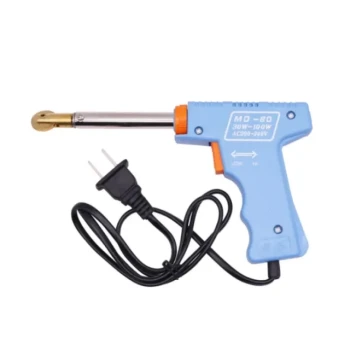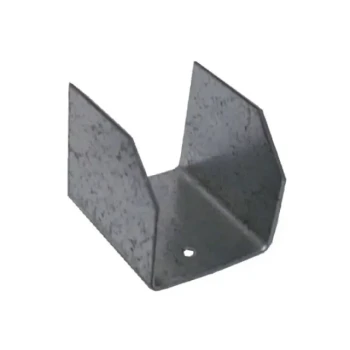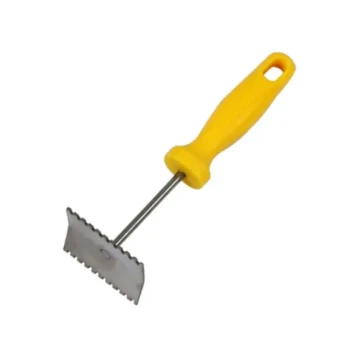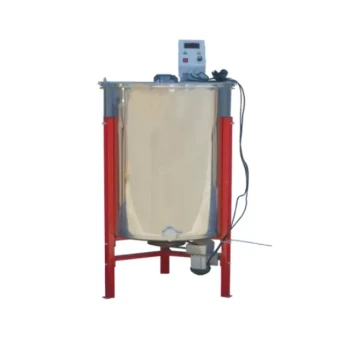At its core, a beehive frame is a simple rectangular structure designed to hold the honeycomb within a hive. It consists of four main wooden or plastic components: a top bar, two side bars, and a bottom bar. This design is what makes modern beekeeping possible, allowing beekeepers to inspect the colony and harvest honey without destroying the hive.
While a frame is just a simple rectangle, its true purpose is to create a modular, removable "page" in the book of the colony. This system allows beekeepers to manage the hive's health, growth, and productivity with minimal disruption.
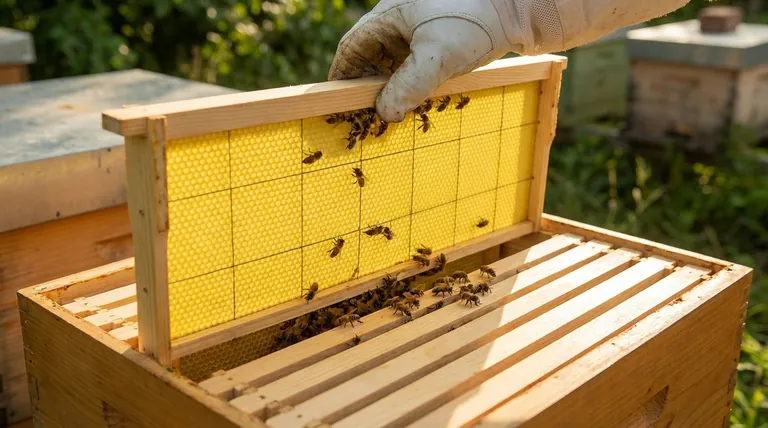
The Anatomy of a Beehive Frame
Each part of the frame is engineered for a specific function, working together to create an ideal structure for the bees and the beekeeper.
The Top Bar
The top bar is the primary support for the entire frame. Its ends are designed to be longer than the frame is wide, creating "ears" or "lugs."
These protruding ends rest on a recessed ledge inside the hive body called a rabbet. This is how the frame hangs securely within the hive box, suspended and perfectly spaced.
The Side Bars
The two side bars provide the vertical structure and are crucial for maintaining correct spacing. Many side bars have small holes drilled into them.
These holes allow beekeepers to thread reinforcement wire horizontally across the frame, providing extra support for the heavy wax comb that will be filled with honey or brood.
The Bottom Bar
The bottom bar completes the rectangle, providing stability and a lower boundary for the comb. It is typically the thinnest piece of the four components.
Foundation (The "Canvas")
While not part of the frame's structure, foundation is a critical component that is placed inside it. This is a thin sheet of beeswax or food-grade plastic imprinted with the hexagonal pattern of honeycomb cells.
Foundation acts as a guide, encouraging bees to build straight, even comb that is easy to inspect and manage. It significantly speeds up the comb-building process for the colony.
How a Frame Functions Within the Hive
Understanding the frame is understanding the logic of the entire hive. Its design is based on a key principle of bee behavior.
The Concept of "Bee Space"
Modern hives are built around the principle of bee space—a gap of about 3/8 of an inch (or 9.5 mm). Bees will not build comb in a space this size, but will instead use it as a passageway.
Frames are designed and spaced to maintain this exact gap between each comb face and between the outer combs and the hive walls. This prevents bees from building unwanted burr comb that would glue all the frames together, making inspection impossible.
The Frame's Role in Hive Management
Frames allow beekeepers to act as hive mechanics. By pulling out individual frames, a beekeeper can check the queen's laying pattern, look for signs of disease, and determine when the colony needs more space.
The frames in the lower boxes, called brood boxes, are primarily used by the queen to lay eggs and raise new bees. The frames in the upper boxes, or honey supers, are where bees store surplus honey.
Understanding the Trade-offs
Not all frames are created equal. The choices you make will impact your management style, your bees, and your budget.
Wood vs. Plastic
Wooden frames are traditional, natural, and what many beekeepers prefer. However, they require assembly (nailing and gluing) and can be more susceptible to damage over time.
Plastic frames, often sold as a single molded piece with foundation included, are extremely durable, require no assembly, and are easy to clean. Some beekeepers feel that bees are slower to accept and build on plastic.
Foundation vs. Foundationless
Using frames with foundation gives the bees a head start and ensures perfectly straight combs, which is ideal for honey extraction with a centrifuge.
Foundationless beekeeping involves giving the bees an empty frame with only a small starter strip as a guide. This allows bees to build their own natural-sized cells but can result in cross-comb if not managed carefully, making inspections difficult.
Making the Right Choice for Your Goal
Your choice of frame depends on your beekeeping philosophy and what you want to optimize for.
- If your primary focus is getting started easily: Choose one-piece plastic frames with a pre-coated wax foundation for durability and simplicity.
- If your primary focus is cost-effectiveness and a traditional approach: Choose unassembled wooden frames and install wax-coated plastic foundation yourself.
- If your primary focus is natural beekeeping: Choose wooden frames and go foundationless or use frames with pure beeswax foundation.
Ultimately, the frame is the fundamental interface between the beekeeper and the colony, and choosing the right one is your first step toward a productive hive.
Summary Table:
| Component | Primary Function | Key Feature |
|---|---|---|
| Top Bar | Main support; hangs the frame | Has 'ears' or 'lugs' that rest on the hive's rabbet |
| Side Bars | Vertical structure; maintains bee space | Often have holes for reinforcement wire |
| Bottom Bar | Completes the rectangle; provides stability | Typically the thinnest component |
| Foundation | A guide for bees to build straight comb | Sheet of wax or plastic with a honeycomb pattern |
Ready to Build a Stronger Hive?
Understanding the components is the first step; equipping your apiary with high-quality, durable frames is the next. Whether you're a commercial beekeeper managing thousands of hives or a distributor supplying the industry, the right equipment is non-negotiable for hive health and productivity.
HONESTBEE supplies beekeeping supplies and equipment to commercial apiaries and beekeeping equipment distributors through wholesale-focused operations. We provide the reliable, scalable solutions you need to succeed.
Let us help you optimize your operation. Contact HONESTBEE today to discuss your specific needs, request a quote, or learn more about our wholesale offerings.
Visual Guide
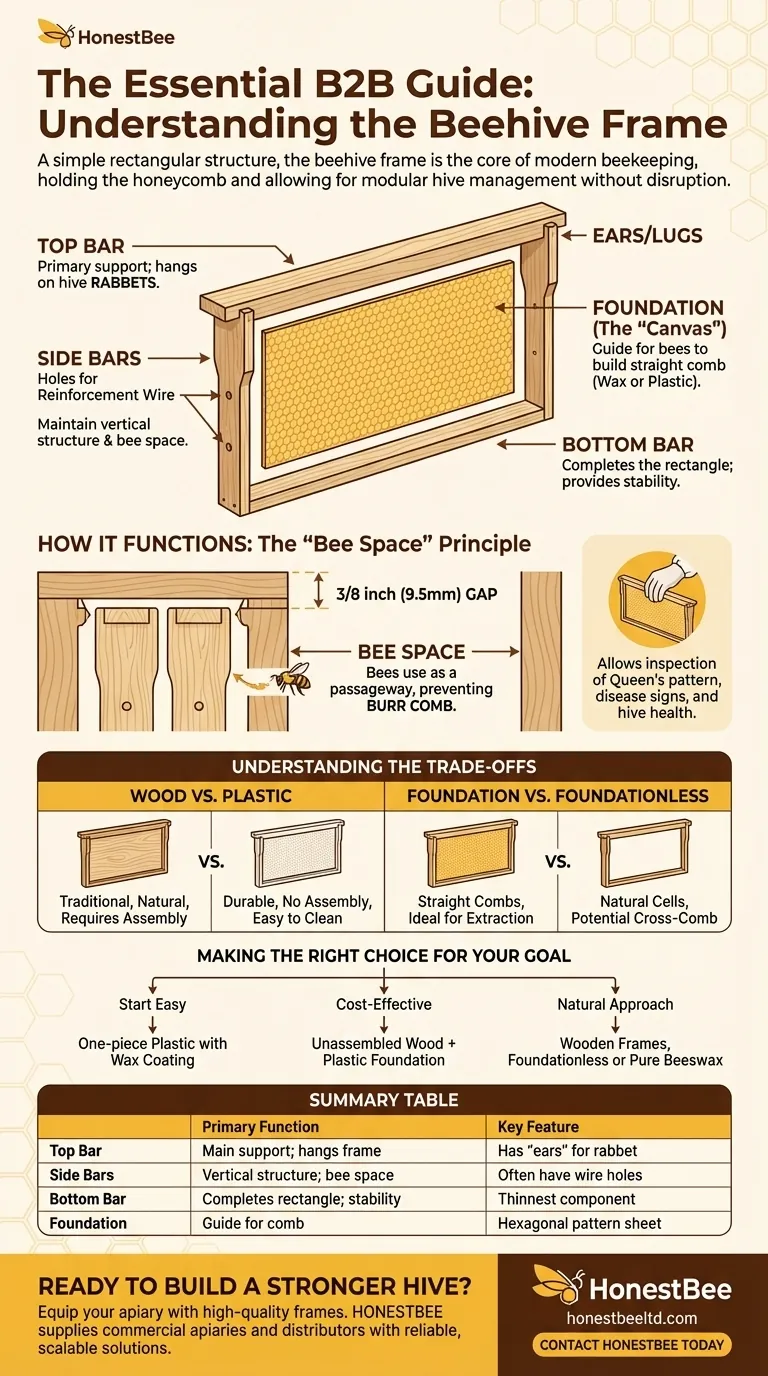
Related Products
- Assembled Wooden Bee Frames with Beeswax Foundation Ready to Use by HONESTBEE
- Automatic Honey Flow Beehive 4 Frame Mini Hive for Beekeeping
- JZBZ Langstroth Queen Rearing Frame for Beekeeping
- Wholesales Dadant Size Wooden Bee Hives for Beekeeping
- Professional Wooden Requeening Frame for Beekeeping
People Also Ask
- How are Langstroth beehive frames assembled? A Step-by-Step Guide for a Durable Hive
- Can old bee frames be reused? Weighing the Risks vs. Rewards for Your Hive
- What are the main parts of a hive frame? A Guide to Modern Hive Anatomy
- How do wooden frames perform during honey extraction? Superior Rigidity for a Smoother Harvest
- What are bee frames, and how do they relate to box sizes? A Guide to the Langstroth Hive System









